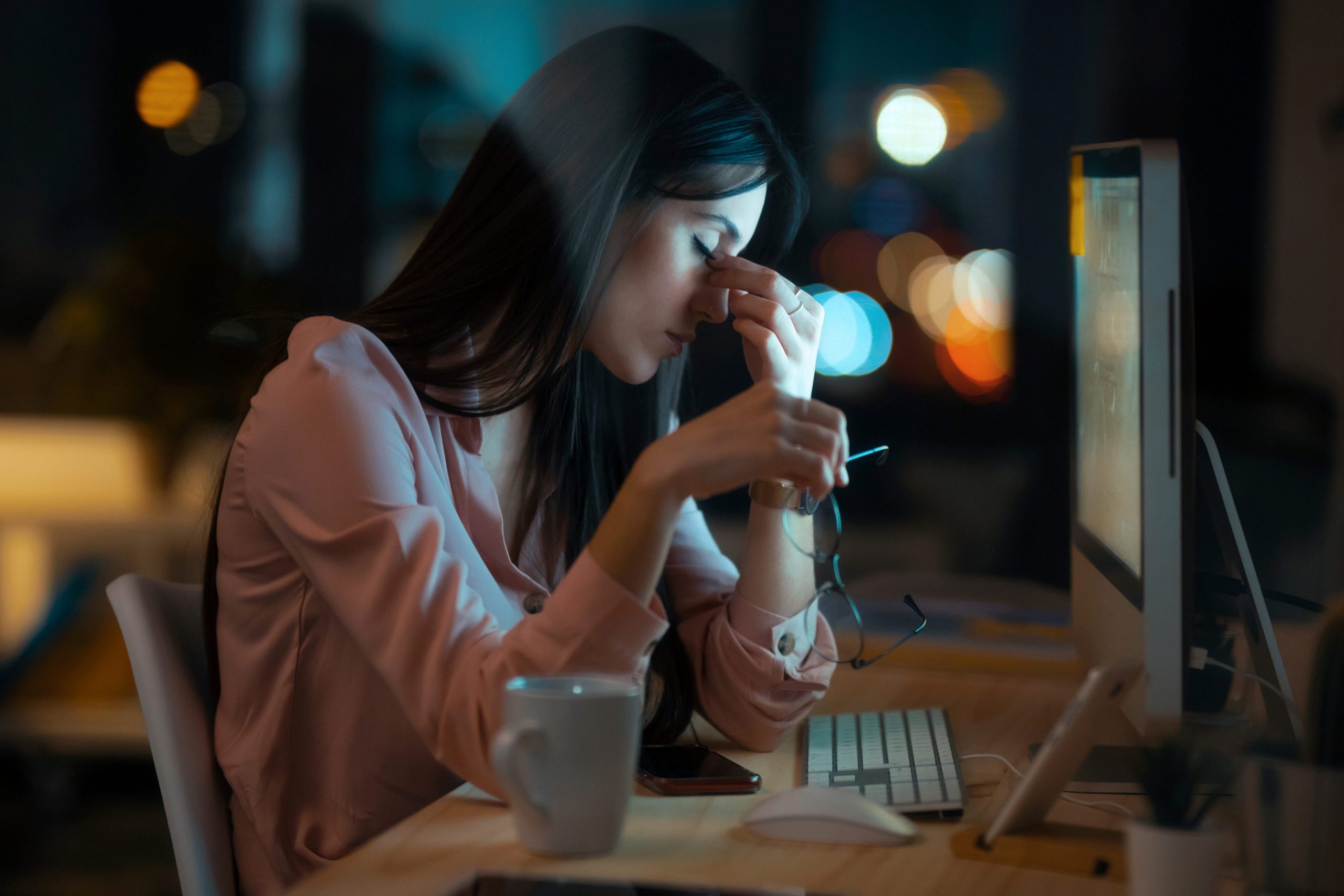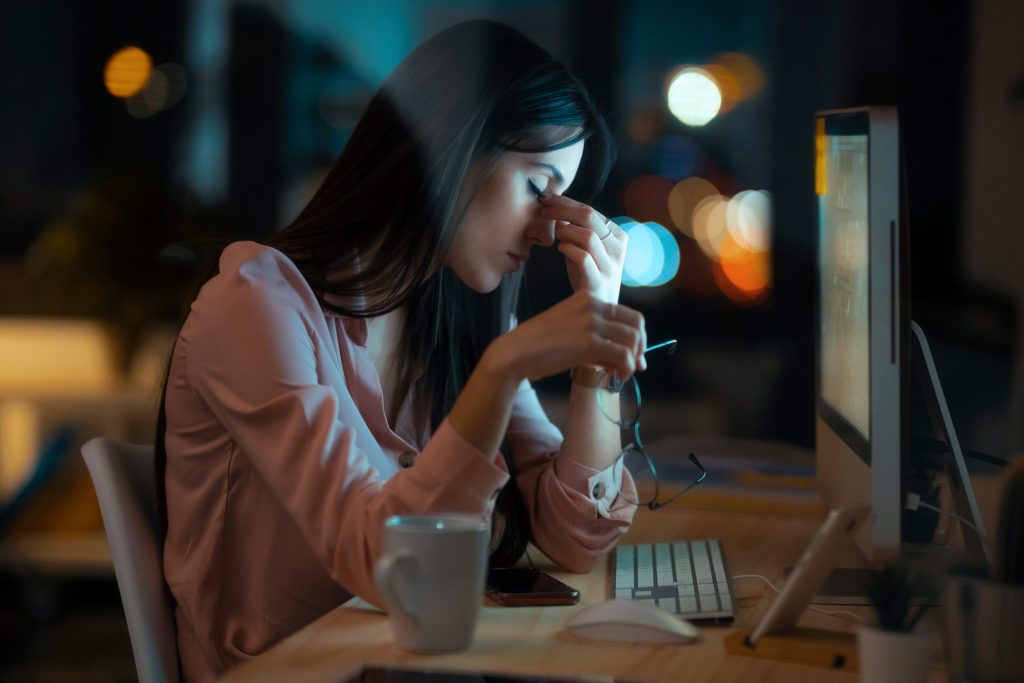
- "Masking" is a term many communities use for hiding their symptoms in order to fit in.
- While working from home, many ill and disabled workers got a break from masking their illness from others.
- But as offices reopen, many have returned to masking — and the pain it brings.
When community college professor Cathy Crea works from home, she leaves the lights off and relies on natural light, keeps her space quiet and fragrance-free, and wears a headache hat that keeps ice pressed against her pounding head. When Crea works on campus, she can't control any of that — and her migraines take notice.
Though the COVID-19 Delta variant rampaged the country this summer, hospitals are turning away patients due to lack of capacity, and 2,000 Americans are dying daily from the virus, many offices and workplaces are reopening and asking employees to return to their desks. For chronically ill and disabled workers, the push to return to the office is even more fraught: When working from home, they were free to be as sick as they felt that day — to close the curtains, to work from bed, to keep a heating pad on their stomachs. But in returning to the office, they return to an old habit: masking.
Masking, a concept that's prevalent in the autism community, is a term used to describe the herculean task chronically ill and disabled people undertake to hide their symptoms and pain to pretend to be well in front of able-bodied people.
Crea spent most of the pandemic working from home before returning to campus a month ago. When a migraine hits while she's teaching, she keeps herself standing despite the accompanying vertigo by clutching the lecture stand.
In those moments, she says her "teacher brain" takes over and she automatically keeps going, pushing through the pain and masking until she can be alone. After class, she retreats to her office where she can control her environment and drop her chronic-illness mask. She sifts through her migraine kit, choosing which abortive medication to take, and fills her ice pack to press it to her aching head. She shuts off the overhead lights and sits in a chair away from the window so no one can see her as she waits for the pain to quiet. But while she's in the classroom, she masks her illness.
"I was telling one of my classes this semester that I have migraines but I push through and fake it," Cathy said. "And one of my students blurts out, 'But you shouldn't have to do that, though.' He's totally right."
When it's time for class again, she puts her ice pack away and returns to her fluorescent-lit classroom. Crea told Insider masking comes naturally to her: Sometimes, she doesn't even realize she's doing it until she gets home and crashes into the pain that was waiting for her.
"I crash at the end of the day," Crea said. "This weekend, I spent a day and a half just not functioning at all. I don't have energy to do anything more strenuous than turn the pages of a book."
For one therapist with endometriosis and chronic pain who spoke with Insider, the ability to work from home during the pandemic was a welcome balm to the realities of living with a chronic illness.
When staying home, she had access to everything she needed in case of a flare: loose clothing, a heating pad, bathtub, and medications. She rested between therapy sessions without fear of seeming unprofessional or incapable. Now, as she transitions back into the office, she says masking adds another layer of pain to her chronic illness.
"Masking takes a lot of energy," she said. "I'm having to consider working from home more simply because of the toll it's all taking on my body, and I feel a lot of shame around that."
There's also an acute feeling of shame around masking: If she masks well, people may not believe she's actually sick; if she doesn't mask well, people may downplay her pain.
"It's all so complicated," she said. "I'm drained emotionally and mentally afterwards to a whole new level."
Toblin, who has ADHD and autism, is a cyber-crime investigator. He chose to use a pseudonym because of the sensitive nature of his work. He told Insider that masking at work takes so much mental and physical energy, he's too exhausted when he gets home to handle household tasks like doing the dishes or cleaning his apartment.
Neurotypical or able-bodied people, he said, don't understand the sheer effort it costs to mask well enough to appear functional. When he finally gets home and can pull the mask down, there isn't any energy left for anything else.
"I have to be a neurodivergent person living in a neurotypical society and by neurotypical standards," Toblin said. "It takes an enormous amount of physical and mental energy."
To be chronically ill or disabled is a constant effort to balance a set of complex and interlocking factors to manage your symptoms. Did you sleep enough or too much? Did you eat the right food at the right time? Did you take your preventative medication too often this month? Is your health insurance even covering your medication anymore? Do you have the energy to make it to work today? How can you explain that yes, you're sick again, because chronic illness means you will always be sick in some capacity? How do you manage everything that life demands on top of managing your unruly body?
On top of these ever-present demands, there's the pressure to mask — to present as able-bodied and neurotypical, to keep your sickness away from those who don't have to live with it themselves.
For a time, while working from home, chronically ill and disabled workers got to drop their masks and just exist in their bodies in the most comfortable ways they could. But as offices reopen, workers are replacing their masks, and forcing their bodies into environments that aren't meant for them.
